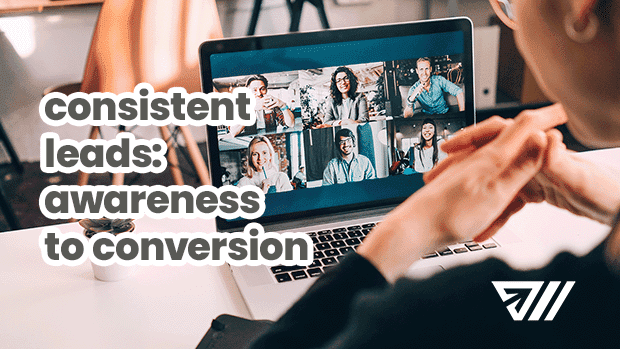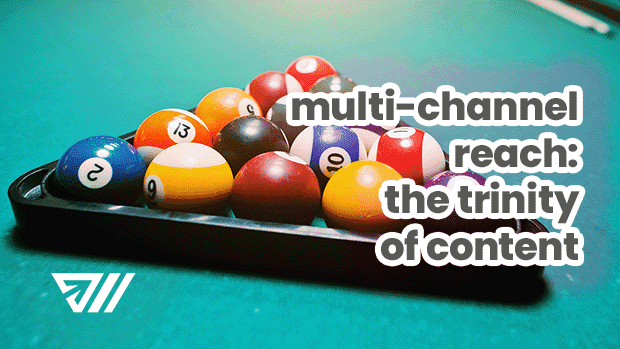Content Marketing Strategy:
Guided by Data
Information is at everyone's fingertips, and there is a lot of noise. Your business has to find ways to stand out. One of the most effective ways to achieve this is through content marketing. And to get reliable results with content marketing, you have to develop a strategy.

What is Content Marketing Strategy?
A Content Marketing Strategy is a written plan guiding the creation and distribution of content that your ideal customer will find valuable. A strategy dives deep into the 'why' behind every piece of content. Are you trying to educate, promote a product/service, or address common concerns? The primary objectives are to foster audience growth, engagement, and retention.
A well-implemented strategy will position your business as an industry authority. Consistent, high-quality content will resonate with your ideal client's needs and interests. You gain the prospect's trust and earn credibility in the industry. This strategic approach not only educates and informs but also influences consumer behavior. Your brand becomes the preferred choice for potential customers who are ready to buy.
A Content Marketing Strategy Verses A Content Plan
"Content marketing strategy" is frequently used interchangeably with "content plan." While related, each serves distinct purposes.
A Content Marketing Strategy answers fundamental questions:
- Why are you creating content?
- Who are you making it for?
- How does your content align with your broader business goals?
The strategy helps you understand your ideal customer's needs, preferences, and pain points. A strategy defines the brand's unique value proposition in the content space. It sets clear metrics for success. In essence, a content marketing strategy provides a holistic view. It defines the direction and purpose of all content initiatives. It's the "why" behind your content efforts.
A Content Plan is more tactical and operational. It's the "how" of implementing the strategy. The content plan details content creation, distribution, and management specifics. It includes a content calendar outlining the content to publish, when, and on which platforms. The plan specifies content formats (blogs, videos, infographics, or podcasts). It allocates resources, sets deadlines, and designates responsibilities. A content plan encompasses methods for content promotion, distribution channels, and engagement tactics. In short, while the strategy provides the vision, the content plan lays out the actionable steps to realize that vision.
Content strategy and plan work together, making your efforts purpose-driven, organized, and aligned with broader business goals.

Inbound Marketing Is The Primary Goal
Content marketing is the heartbeat of any successful inbound marketing strategy. Inbound marketing is about creating value for potential customers. It draws their attention instead based on their existing interest. Inbound marketing differs from traditional interruption advertising methods with broad targets.
This shift from interruption to attraction is where content marketing shines. The technique revolves around producing relevant content tailored to specific interests. Once you know your ideal client, you can understand what they need. Your content can then attract traffic to your website or social media channel.
Content marketing fuels each stage of the inbound method. First, there's the 'Awareness' stage. Blog posts, videos, and infographics raise awareness and attract potential leads.
Next, your leads move to the 'Interest' stage. You can use ebooks, webinars, and case studies to nurture and deepen the relationship here. The purpose of this stage is to guide them closer to a buying decision.
In the 'Consideration' stage, you can use deeper, long-format content to nurture the sale. Common examples include deep, topical YouTube videos, podcast episodes, and informative drip emails.
The 'Conversion' stage is when you can introduce limited-time offers and demos. You can also reinforce their confidence with customer testimonials.
Finally, in the 'Retention' stage, create content that promotes advocacy and rewards loyalty. You should continue to educate these customers with your content. And, when appropriate, this is also where you can up-sale. Content can show how add-on products and services build upon their successful experience.
Content Marketing and Inbound Marketing Are Data-Driven
The data-driven nature of inbound marketing complements content marketing efforts. You can tweak your content strategy by analyzing user interactions, preferences, and feedback. Your content will stay aligned with prospect needs and market trends. This iterative process ensures that content remains effective, relevant, and engaging.
Inbound marketing provides the framework, guiding leads from awareness to advocacy. Content marketing provides the substance, the valuable material that informs, engages, and delights. Together, they form a holistic strategy. They allow you to focus on customer needs, build your reputation, and drive sustainable business growth.

How Content Drives Leads Into Your Marketing Funnel
Content marketing serves as a bridge. It connects potential customers to businesses through an organic and value-driven approach. But how exactly does content marketing move a lead into your marketing ecosystem?
Content marketing is about offering value to your ideal customers. The content could be a blog post that answers a pressing question. Or a video tutorial that demonstrates a solution. Or an infographic that breaks down complex data. Content marketing addresses the specific needs and pain points of the audience. When your content resonates with a prospect, they are more likely to engage with your brand. This engagement is the beginning of their journey into your marketing funnel.
The top of the funnel is the 'Awareness' stage. Here, content marketing plays a pivotal role in capturing attention. High-quality, relevant content positions you as an authority in your field. It builds trust. People become aware of your brand and its offerings. And they seek out more information, moving them into the 'Interest' stage.
In the 'Interest' stage, you build upon the prospect's curiosity. You give potential customers a good reason to share their contact information. That reason is what's called a lead magnet. Lead magnets can be ebooks, webinars, events, or special offers. You ask for their name and email; in exchange, they get helpful, free content.
Content marketing continues your lead's journey in the 'Consideration' stage. Detailed case studies, product comparisons, and expert reviews provide deep insights. Prospects are evaluating their options and making comparisons. Your content should educate and reinforce your brand's value proposition. You are nudging leads to choose you over your competitors. The content makes you more accessible, helpful, and trustworthy.
Content marketing seals the deal in the 'Conversion' stage of the funnel. Testimonials, product demos, and special offers give leads the final push they need. Delivering value at every stage of the funnel attracts and nurtures your leads. Content marketing transforms casual browsers into loyal customers.
Finally, we build upon that loyalty in the 'Retention' stage. We use content to turn your customers into advocates. Your content becomes a part of your exceptional customer service. Loyalty and referral programs connect your business with their friends, family, and colleagues.
Identify your ideal customer and learn their needs. Armed with that knowledge, you can deliver targeted, valuable content. Your businesses can drive conversions and foster lasting relationships.

When Should A Business Develop A Content Marketing Strategy?
When is the right time for a business to develop a content marketing strategy? The answer is as soon as possible.
The foundational goal of business is to connect with potential customers. You do that by communicating your value proposition and fostering trust. A content marketing strategy aids in achieving these objectives. Early on, you may have few products or a sprawling customer base. Still, content can help you establish brand identity, voice, and ethos. It sets the tone for future interactions and begins the audience-building process.
As your business grows and evolves, so do its goals and challenges. Are you launching a new product? Or entering a new market? Or are you now facing increased competition? Each situation will trigger a unique set of objectives. A well-defined content marketing strategy will address each of these situations. It keeps your brand's messaging consistent, targeted, and effective in each situation. A strategy provides a roadmap. It guides the planning of content creation, distribution, and analysis. The strategy ensures that content aligns with your business's current goals.
Your ideal customers are being pummeled with information daily. Competitors don't always deserve the business they are getting. You can avoid getting lost in this noise with a strategic approach to content. A content marketing strategy helps in differentiating your brand. It allows for content that is seen, resonates, engages, and drives action.
Additionally, the digital landscape is ever-evolving. New platforms emerge, algorithms change, and consumer behaviors shift. A content marketing strategy provides an adaptable framework. It allows your businesses to roll with changes while keeping sight of objectives. It offers clarity, direction, and a mechanism for continuous improvement.
The question isn't when a business should develop a content marketing strategy. It's how long you can afford not to have one in place. A content marketing strategy is not only beneficial - it's essential. It provides direction, enhances visibility, fosters engagement, and drives growth and success.
The Various Strategies Used For Content Marketing
In content marketing, one-size-fits-all approaches don't work. Businesses use a myriad of strategies to ensure their content connects with customers. Let's explore some of these multifaceted strategies.
Storytelling and Brand Narrative
Storytelling is one of the most compelling ways to connect with an audience. Businesses craft a cohesive brand narrative that informs while also evoking emotions. This narrative can be around the brand's origin story or customer success tales. The narrative can be behind-the-scenes glimpses showing how your approach is superior. Storytelling humanizes your brand, making it relatable and memorable.
Educational Content and Thought Leadership
One successful approach is creating educational content. The content can be how-to guides, tutorials, webinars, and ebooks. Through these lead magnets, businesses position themselves as experts in their field. This strategy provides value and establishes your brand as a thought leader. You become a go-to source for information and insights.
User-Generated Content (UGC)
Some businesses encourage customers and followers to create and share content. This user interaction can be a powerful branding strategy. The customer could post reviews, testimonials, or social media posts. These customer activities add authenticity to the brand narrative. It leverages the community's voice, building trust and fostering engagement.
SEO-Driven Content
Innovative brands create content with a keen eye on search engine optimization (SEO). Very few industries exist for which search engine rankings aren't critical. SEO is also one of the most misunderstood sectors of marketing. The key takeaway is that SEO is only effective when you develop a content plan from reliable data. Comprehensive keyword research and analysis will tell how people search for your solutions. Many factors influence rankings. We use a 26-data-point system of research and analysis. Our process yields a prioritized list of the precise topics your content plan should include. Keyword research is a critical component of your content marketing strategy.
Interactive and Multimedia Content
Interactive content like quizzes, polls, infographics, and videos can capture prospect interest. Such content engages and offers a dynamic way to present information. It helps to make complex information more digestible and shareable.
Personalized Content
With data analytics and AI advancements, businesses can tailor content to individuals. Tailored content can include personalized email campaigns, product recommendations, and dynamic website content. This messaging caters to specific user behaviors and preferences. It enhances the user experience and increases conversion rates.
You will use a mix of these strategies in your content marketing strategy A mix of strategies can ensure your content remains impactful, relevant, and conversion-centric.
Robust Keyword Research:
An Essential First Step of Content Marketing Strategy
Robust keyword research is the foundational step in a content marketing strategy. Keyword research is not only about identifying popular topics. It's about understanding your target prospects' intent, needs, and language. It aligns your content with relevant search queries. So, your content provides your ideal customers with the answers they need.
Keyword research offers a peek into the minds of potential customers. It reveals what they are searching for. It captures the questions they're asking and the problems they're trying to solve. You can tailor content to speak to your prospect's needs. Your brand resonates and engages your ideal customer. This alignment between content and user intent boosts organic traffic to your website. But not all traffic is productive traffic. Robust keyword research ensures that the traffic you get is relevant.
Keyword research gives you insight into market trends and shifts in consumer behavior. It allows your business to stay ahead of the curve and find untapped opportunities. Your content remains timely, relevant, and in tune with current demands. Our approach pulls data from your current search competitors as well. This comparison gives us a baseline of what currently ranks. But it also allows us to exploit weaknesses in your competitors' content. This proactive approach gives you an edge. You establish your brand as an industry leader at the top of Google search rankings.
Messaging that is convincing to your ideal customer is great to have. But it's not very useful to you if they never see it. Your content has to serve two audiences at once: users and algorithms. Keyword research provides direction, clarity, and focus to communicate with both. You can simultaneously align your content with customer needs and search engine algorithms. You indicate to platforms like Google where and how to position you. Users find your content, and it connects with them.
How On-Page and Off-Page SEO Factor Into A Content Marketing Strategy
There's a symbiotic relationship between content marketing and SEO. And with that, both on-page and off-page SEO come into play. When integrated into a content marketing strategy, they amplify your reach and impact. They drive organic leads and enhance brand visibility.
On-page SEO is work that optimizes your web pages to rank in search engine results. It deals with everything you can do on your pages and website. This work includes keyword placement, meta descriptions, headers, and URL structures. But it goes beyond these SEO basics. On-page SEO considers the content quality of your website. It ensures that you provide value in a digestible way for readers and search engine bots. Technical aspects like page load speed also play a pivotal role. On-page SEO ensures that the content communicates with prospects and search engines.
Off-page SEO focuses on external signals pointing to your website from other sites. It's a testament to your content's credibility, relevance, and authority. Off-page SEO is about where your brand sits in the broader digital ecosystem. Inbound links from reputable sources are a significant component of off-page SEO. They act as endorsements. Backlinks signal to Google that you are trustworthy and that your content is valuable. But off-page SEO isn't only link-building. Social signals like shares and mentions on social media platforms are also influential. Within a content marketing strategy, off-page SEO amplifies the reach of your content. Off-page strategies help you foster trust and authority in the industry.
On-page SEO provides a robust content foundation. Off-page SEO builds your authority. Together, they form a cohesive strategy that maximizes online visibility, engagement, and conversions.
How Guest Posting Fits Into A Content Marketing Strategy
Guest posting is contributing content to another person's website or blog. It has long been a staple in the toolbox of content marketers, and for good reason. Guest posting can mutually benefit both the guest writer and the host site.
Guest posting is a potent tool for building authority and credibility. Sharing expertise on reputable platforms can position you as a thought leader.
But, the most significant advantage of guest posting is backlink generation. Quality backlinks are a big part of search engine rankings. Search engines weigh backlinks from reputable sites as a vote of confidence. These backlink votes boost your site's authority and ranking. Increased authority increases organic traffic, amplifying the brand's visibility in search results.
Guest posting is an opportunity to cover related topics that don't fit into your content plan. You can share thoughts on industries or broad topics that might alienate prospects visiting your site. Yet, your website still gets the benefit of the backlink. At Websuasion, we mark those keywords that aren't a perfect fit as guest posting topics.
Keyword Focused Articles
Keyword-focused articles are a cornerstone of a content marketing strategy. At Websuasion, we start here. We integrate specific keyword phrases that potential customers search for into the copy. These keywords send cues to search engines telling them how to position the page. Search engine algorithms see these articles as providing genuine value to their users. They answer questions, solve problems, and show your brand as an authority in its niche. Over time, publishing keyword-focused articles enhances your brand's online presence. Articles drive sustained traffic and foster trust with your ideal customer.
Long Format Videos
The adage "show, don't tell" holds especially true in content marketing. Long-format videos are a testament to that. These videos offer a deep dive into topics. They allow your business to explore nuances, share stories, or provide detailed tutorials. Within a content marketing strategy, long-format videos serve many purposes. They cater to an audience that prefers visual and auditory learning. They increase the time spent on your content and offer an immersive experience. Platforms like YouTube also favor longer, engaging videos. Long-format videos boost engagement and drive conversions. At Websuasion, we create video content from our researched article content. The article becomes the script for the video, and the video gets embedded into the article. They work together between search engine results and YouTube search results. That means twice the search presence from each keyword topic.
Podcast Episodes
Podcasts have seen a rise in popularity and for a good reason. They offer convenience and depth. Listeners can consume long-form discussions and interviews on the go. Incorporating podcasts into a content marketing strategy allows your reach to grow. Podcasts are perfect for establishing thought leadership. You can dig into industry trends or host experts and influencers. Podcasts foster a sense of intimacy with listeners. Listeners often feel a personal connection to the host and the brand. Podcasting can help in building a loyal community. It can enhance brand loyalty and establish authority in a particular field. At Websuasion, podcasting is the third spoke of the content wheel. We often pull the audio from our long-format videos to use in the podcast episode. Conversely, we will film podcast sessions and use them as long-format video content.
No matter which comes first, we coordinate and re-format all keyword-targeted content. Our clients get articles, videos, and podcast episodes that target their keywords.
Content Distribution Across Various Platforms
But we go beyond producing the trinity of content. We use edited versions of long content to feed into content for paid ads, social media posts, and email campaigns.
How Paid Ad Content Fits Into A Content Marketing Strategy
Paid ad content is an integral component of a holistic content marketing strategy. PPC campaigns serve as a catalyst to amplify reach. Paid ads offer the unique advantage of immediate visibility and targeted reach. Ad platforms allow precise targeting based on demographics, interests, and behaviors. Paid content can be sponsored posts, display ads, or search engine marketing. We align your brand's organic content efforts with your paid ads campaigns. The organic source content gives a more natural feel to a paid placement. And often, the ad performance of this content is superior. Also, aligning your ads with your targeted keywords reaches your ideal customers. Ads using video shorts or infographics lead potential customers into your marketing funnel. The lead capture rates become predictable and more straightforward to measure for ROI. Our ultimate goal is to replace this paid traffic with organic alternatives. But paid ads allow us to drive traffic while waiting for the algorithms to do their thing.
Engaging Social Media: Video Shorts, Infographics, Images
Social media is the frontline of modern content marketing. It gives your business direct engagement with your customers and prospects. Video shorts, infographics, and images play pivotal roles within this space. Video shorts are perfect for capturing the attention of new prospects. You can use them for product demos, customer testimonials, or even behind-the-scenes glimpses. Infographics simplify complex data, making it striking and easy to understand. They're excellent for showcasing statistics, processes, or lists. Images can be high-quality photos, graphics, or user-generated content. Images add vibrancy to your brand's social media profile. Together, these elements make your social media presence more engaging. They drive interactions, shares, and conversions.
Email Drip Marketing in Content Marketing Strategy
Email drip marketing is a powerful tactic within a comprehensive content marketing strategy. We design emails to nurture leads and engage customers through automated, scheduled email sequences. These tailored sequences deliver relevant content to the subscriber's inbox. The emails provide consistent brand touchpoints for prospects who need time to decide. Or they can provide a better customer experience. Drips may be a series of onboarding emails for new subscribers. Or they may be educational content for potential customers. Automated drip campaigns provide timely and targeted information before and after purchase. They are crucial to guiding recipients through the sales funnel. At Websuasion, we repurpose select points from your long-format content. Our drip emails highlight the critical information customers may have missed. The action-triggered nature of drips allows us to deliver content in context with user behavior. Email drip marketing enhances user engagement and trust. It drives conversions and strengthens long-term customer relationships.
Importance and Benefits of a Documented Content Marketing Strategy
A well-documented strategy serves as a roadmap, guiding all content marketing efforts. It ensures that everyone is on the same page, leading to:
Achieving Specific Business Goals
Is your goal increasing website traffic, generating leads, or boosting sales? A clear strategy aligns all content efforts towards your target goals.
Defining Clear Success Metrics
How do you measure the success of a blog post or a social media campaign? A strategy outlines key performance indicators (KPIs) to track and measure.
Enhanced Customer Engagement
With a clear strategy, businesses can produce content that resonates with prospects. This content leads to increased engagement and loyalty once they become a customer.
Core Components of a Content Marketing Strategy
Every effective content marketing strategy comprises several core components:
Ideal Customer Personas
Who are you creating content for? Understanding your ideal customer's needs, preferences, and pain points is crucial.
Brand Story and Positioning
This report encapsulates what your brand stands for, its history, values, and mission.
Content Marketing Mission Statement
Your mission statement defines the unique value your content offers. It's the promise you make to your audience.
Business Case
Here, you outline the benefits of content marketing, potential risks, and what defines success.
Operations Plan
The operations plan deals with logistics. How will you create, publish, manage, and measure your content?
Channel Plan
Where will you publish your content? Each channel should have a clear purpose and strategy and be where your ideal customer goes.
10 Steps to Develop a Comprehensive Content Marketing Strategy
Content marketing strategy development can be a daunting undertaking. But by breaking it down into manageable steps, it becomes much more approachable. We guide our clients through this process with the following steps.
1. Determine Your Audience
Use data and insights to understand who your audience is and what they're interested in. What platforms and channels are they using online? Are their interests, demographics, or behaviors they often have in common?
2. Rank Your Products and Services
Which of your products or services are the easiest to sell? Which ones earn the most profit? Are there emerging markets you want to tap into?
3. List Who You Think Your Competitors Are
Most business owners have a pretty good idea of who their competition is. You see their advertisements. You know people in their industry who work for them. You see them bid against you. You are very aware of the ones who produce shoddy work. Make a list of them here. But we're going to reevaluate these in a later step.
4. Perform Robust Keyword Research
Your ideal customer will surprise you. They will be looking for solutions in ways you have yet to consider. And they'll be in places you never imagined. We use a 26-data-point research and content strategy approach that is the best in the industry. It takes out the guesswork with content development.
5. Reevaluate Who Your Competitors Actually Are
Seeing the keyword research, are you surprised to see your actual search competitors? Keyword research opens the eyes of every client I've had. They see the competitive landscape in a whole new light. They've focused on the older, established competitors who often need to catch up with the technology curve. What they assumed to be significant competitors frequently do not show up in search. Now, they can see all the newer upstarts chiseling away at their online opportunities. They may be less experienced, but they are more tech-savvy and agile.
6. Determine Your Differentiators
What do you provide that is better than others in your market? What is your competitive edge? How can you show prospects the difference? Do you know why when you close a deal or make a sale? This information is critical to developing the right messaging for your brand.
7. Decide What Is A Lead Worth To You
If I could hand you a lead right now who is ready to close, how much is that worth? What's the most you'd be willing to spend? This information will allow you to calculate your ROI (return on investment).
8. Set A Reasonable Budget
How much can you afford to invest in digital marketing each month? Knowing this will help you set reasonable expectations for your content strategy. The more limited your budget, the more critical it is to focus on the most productive elements.
9. Understand Your Tech Stack
What will you need to create, distribute, promote, and track your progress? What will you use to build your website? A good CMS can streamline content creation, publication, and analysis for non-technical staff. But it will also create security risks, impact webpage speed, and overcomplicate things. It's essential to get clarity on these issues in your Operations Plan. If your development team will publish content with design changes, you can use an alternative. At Websuasion, we often recommend a site developed in ReactJS with GatsbyJS. This approach generates lighting-fast pages with unlimited design flexibility.
10. Put It All Together Into A Written Document
Once you've answered all the above, get your strategy down on paper. Put your next steps into a calendar. Schedule progress reviews. Make each step tangible and actionable.
Challenges and Future of Content Marketing
The digital landscape is ever-evolving, and so is content marketing. With the rise of new platforms and technologies, businesses must stay agile. Artificial intelligence plays an ever-increasing role in content marketing. And that trend is unlikely to slow. There is nothing wrong with leveraging these technologies. Google itself has said it has no problem with AI-generated content. What matters to Google is that the content is accurate and valuable. But as a business and brand, it's critical that you take the reins with your messaging. Avoid spitting out content without giving it your unique stamp. The more distinctive your message, the better your connection to the customer. Use technology for its strengths. Work with professionals for theirs.
Let's Talk!
That's why, at Websuasion, our motto is "Data. Tech. Team." Do the research. Harness the technology. But ultimately, success comes down to human decisions. We hope to get to know you and your business soon. Schedule a call with us today. We're excited to show you the possibilities.
By providing a telephone number, opting in to SMS Text Messaging, and submitting this form you are consenting to be contacted by SMS text message. Message & data rates may apply. You can reply STOP to opt-out of further messaging.










